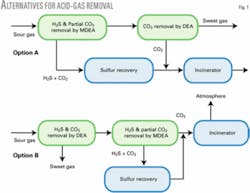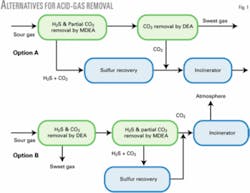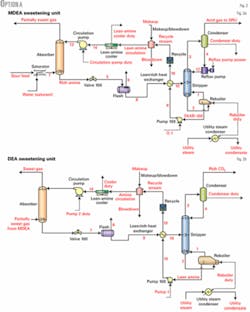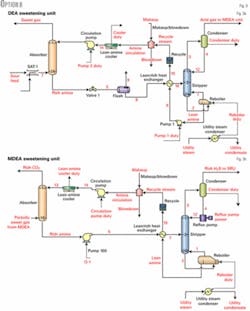A study of two methods for removing H2S and CO2 from natural gas has concluded that an arrangement of methyl diethanolamine (MDEA) and diethanolamine (DEA) units and the order of their use affect the concentration of H2S in the acid-gas feed to the sulfur-recovery unit. The study showed that sweetening natural gas with DEA unit first and separating the acid gases from each other by an MDEA unit at low pressure produce richer H2S in the acid-gas stream, providing a more favorable feed for the SRU. The evaluation also shows that the overall energy consumption is slightly lower for this option.
The main objective of this study was to evaluate two alternatives for removing H2S and CO2 from a natural gas stream while providing the highest quality (i.e., rich H2S) acid-gas feed to the SRU. In addition, nearly total removal of CO2 was required due to the presence of a downstream nitrogen-rejection unit (NRU).
Each alternative consists of two stages of acid-gas removal in series. The first alternative represents an existing unit and the second alternative, proposed here, revamps the existing unit, with minimum capital cost, to improve overall sweetening and sulfur-recovery performance.
Gas sweetening
Hydrogen sulfide and carbon dioxide are the principal objectionable acid-gas constituents often present in natural gas, synthetic gas, and various refinery-gas streams. These constituents must be removed to prevent corrosion in gas pipelines and process equipment and for health and safety reasons. Maddox and Morgan (1998) provide the current acceptable concentration levels for these acid gases in gas streams.1 H2S removal is also often important for production of sulfur needed for sulfuric acid and other use. In natural gas treating, there are several processes available for removal of these acid gases.
Sour-gas sweetening technologies fall into three categories:
- Changes in pressure and temperature.
- Adsorption.
- Absorption.
Sour gas can be sweetened by adjusting the pressure or temperature of the sour gas by fractionation or membranes. It can also be sweetened by adsorption of the sour compounds onto a solid bed of adsorbent. Solid adsorbents can use either physical affinity or chemical reaction to remove the sour compounds from the gas. Sour gas can also be sweetened by absorption of the sulfur compounds or carbon dioxide into a liquid with either physical affinity or chemical reactions or a combination of both physical and chemical forces called “hybrids.”
Aqueous solutions of alkanolamines are the most widely used. The alkanolamine process is characterized as mass transfer enhanced by chemical reaction in which the acid gases react either directly or through an acid-base buffer mechanism with an alkanolamine to form nonvolatile ionic species.
The sour-gas stream, usually at high pressure and a temperature slightly higher than its hydrocarbon dewpoint, enters the bottom of the absorber column, and the lean amine enters the top of the column, also at a temperature higher than the feed-gas hydrocarbon’s dewpoint.
In the absorber column, the acid gases dissolve in liquid phase and react with alkanolamine to form nonvolatile salts (in ionic species form).
For the DEA unit, the gas leaving the top tray of the absorber contains only a low concentration of the acid gases, but for the MDEA unit it may be as high as a few percent of CO2. The warm, rich (in acid gases) amine from the bottom tray of the absorber undergoes heat exchange with the hot lean amine from the bottom of stripper and then enters the top of the stripping column.
In the stripping column, which typically operates at 10 to 12 psig pressure and higher temperature, the reactions reverse, causing the nonvolatile salts to dissociate, releasing the acid gases and regenerating the alkanolamine for reuse in the absorber.
The released acid gases in the overhead product of the stripping column normally flow to an SRU, acid-gas reinjection, or flare system. The hot lean amine from the bottom of the stripper column cools via heat exchange with rich amine, then is further cooled by air or water and pumped back to the top of the absorber column.
Design of a gas-treating unit is complex and often tedious if carried out by hand because mass transfer takes place with phase change in an aqueous electrolyte system. Therefore, both chemical-reaction-equilibrium and vapor-liquid-equilibrium must be considered.2 Maddox and Morgan and Kohl and Nielsen present procedures and example calculations for alkanolamine processes using shortcut methods.1 3 Because of the low concentrations that must be achieved in the sweet gas, however, and high operating cost of alkanolamine treating facilities, determining optimum operating conditions is nearly always desirable. For accurate design and simulation of alkanolamine processes, computer packages are used.
Process alternatives
This study set out to evaluate two alternatives for removing H2S and CO2 from a natural gas stream and producing a rich H2S acid-gas stream suitable for the SRU. Each alternative consists of two stages of acid-gas removal in series. Fig. 1 shows both alternatives.
In Option A, sour natural gas is treated in the MDEA unit to selectively remove H2S and part of the CO2. The partially treated gas then flows to the DEA unit for removal of the remaining CO2. The acid gas from the MDEA unit flows to the SRU. The acid gas from the DEA unit, mainly CO2, and tail gas from the SRU move to the incinerator.
In Option B, all of the H2S and CO2 are removed in the DEA unit and sent to the MDEA unit where H2S is selectively removed at low pressure, producing an acid-gas stream with a higher concentration of H2S that is more suitable for the SRU. The H2S-enriched acid gas from the MDEA unit flows to the SRU. The CO2 from the MDEA contactor moves directly to the incinerator unit.
An existing plant is operating based on Option A; the operators desired to find an alternative to improve the design and reduce the operating cost. Therefore, Option B has been proposed to revamp the existing plant with minimum capital cost.
This article presents the key results of computer simulation for both alternatives and discusses the operational aspects for each.
The required heat duties, power requirements, potential sulfur plant impact and other process parameters for both cases are compared.
The pros and cons of each alternative are discussed and finally the preferred alternative is recommended.
null
Simulation
Figs. 2 and 3 present the process flows for the two alternatives. Table 1 shows the specifications for the absorber and stripper columns. Steam was the source of energy for the regeneration of amines; Table 1 shows its rate and conditions. For the DEA process, the circulation rates were determined under the constraint that the total acid-gas liquid loading in the rich-amine solution stream does not exceed 0.45 moles of acid gases/1 mole of amine and to meet a sweet-gas specification of less than 4 ppm hydrogen sulfide.
In addition, considerations were made to produce a rich H2S stream for the SRU. Achieving these objectives required studying the impact of the key parameters such as amine solution concentration, number of trays, column diameters, column pressures, heating and cooling requirement, and pumping horsepower.
In this study, ProMax and ProTreat simulation softwares were used to perform the computer simulation.4 ProMax is a stream-based process simulation package for design and optimization of gas processing, refining, and chemical facilities.
Benefits include more complete thermodynamic models, calculation of more thermophysical properties, and better integration with hydrocarbon packages and unit operations. These benefits allow the user to model many more processes such as complex absorber and stripper configurations, three-phase flashes, and oils in amine units. The following amines are available individually or as blends: monoethanolamine (MEA), DEA, diglycolamine (DGA), MDEA, di-isopropanolamine (DIPA), triethanolamine (TEA), and aminomethyl propanol (AMP).
ProMax also introduces a new electrolytic model that is a significant improvement to the NRTL (nonrandom two-liquid) acid-gas model. The sweetening package also has the ability to model selective absorption using CO2 kinetics. ProTreat is a gas-treating process simulation tool that uses mass and heat transfer rates to model the towers used in amine-based processes.
Since the simulation results of both softwares were close, only the results obtained by ProMax will be discussed here. Tables 2 and 3 show the simulation results.
null
Results
Table 2 shows that the concentration of H2S and CO2 in the rich H2S streams of Option A are 48.55% and 47.15 mole %, respectively. The corresponding values in the rich H2S streams of Option B are 72.67% and 23.70%, respectively. In addition, because of more CO2 slip in Option B, the rich H2S flow rate of 25.0 lb mol/hr is lower than 37.5 lb mol/hr of Option A.
In Option B, the richer H2S stream was produced at the expense of no extra steam consumption (Table 1) but with much lower pumping horsepower (Table 3). Table 3 shows that the total heating-cooling consumption is almost the same, but the decrease in pumping horsepower is 30 hp. To let more CO2 slip in the MDEA unit of Option B required a smaller contactor diameter (1.5 ft). The contactor diameter for the DEA unit in both options, however, and in the MDEA unit of Option A was 5 ft.
Table 3 gives details of the process conditions for both options.
Our study, based on rigorous computer simulation, showed that the proposed Option B produces richer H2S in the acid-gases stream, producing a more suitable feed for the SRU. H2S in the acid gas increased to 72.67 mole % from 48.55 mole %, while the acid-gas flow rate decreased to 25.0 lb mole/hr from 37.5 mole/hr. Even though the total heat duties did not change, the steam consumption (at the same condition) fell to 8,156.6 lbm/hr from 8,643.6 lbm/hr, equivalent to a 5.6% reduction. The pumping requirements also fell to 49 hp from 81 hp, equivalent to a 39% reduction.
The richer H2S (72.67 mole %) acid-gas stream results in a feed suitable for straight-through Claus plant configuration without preheat. A potential additional benefit of Option B is that less pickup of heavy hydrocarbons from the feed gas is likely with this arrangement. DEA systems have less tendency to absorb heavy hydrocarbons than MDEA, and there is much less contact between MDEA and hydrocarbons in Option B.
The normal butane (all heavier hydrocarbons were treated as normal butane) in the acid gas reduced to 0.0001 mole % from 0.0377 mole %. Amine system foaming problems should be reduced, and there will be less hydrocarbon in the acid-gas feed to the SRU for Option B.
Acknowledgment
The authors acknowledge Optimized Gas Treating Inc. for the use of its ProTreat software in the course of this study.
References
- Maddox, R.N., and Morgan, D.J., “Gas and Liquid Sweetening,” Gas Conditioning and Processing, 4th Ed., Vol. 4, Norman, Okla.: John M. Campbell & Co., 1998.
- Moshfeghian, M., Bell, K.J., and Maddox, R.N., “Reaction Equilibria for Acid Gas Systems,” Laurence Reid Gas Conditioning Conference, Norman, Okla., March 1977.
- Kohl, A., and Nielsen, R., Gas Purification, 5th Ed., Houston: Gulf Publishing Co., 1997.
- ProMax, v. 1.2 (2005), Bryan Research & Engineering Inc., Bryan, Tex.; ProTreat, v. 3.2 (2005), Optimized Gas Treating Inc., Houston.
The authors
Mahmood Moshfeghian ([email protected]) is a senior research engineer at John M. Campbell & Co., Norman, Okla. Before joining JMC, he was professor of chemical engineering at Shiraz University, Iran, where he served as department head and associate dean of research in the college of engineering. He was previously professor of chemical engineering at the University of Qatar and a senior research scientist at the Kuwait Institute for Scientific Research. Moshfeghian holds BS, MS, and PhD degrees in chemical engineering from Oklahoma State University.
Mark Bothamley ([email protected]) is chief engineer with John M. Campbell & Co. His experience covers the areas of design, operation, troubleshooting, and optimization of offshore and onshore oil and gas production and treating facilities. Before joining JMC, he was with BP PLC (Amoco) for 24 years in several locations worldwide. Bothamley holds a BS in chemical engineering from Lakehead University, Thunder Bay, Ont., and a diploma in natural gas and petroleum technology from the British Columbia Institute of Technology, Vancouver.










